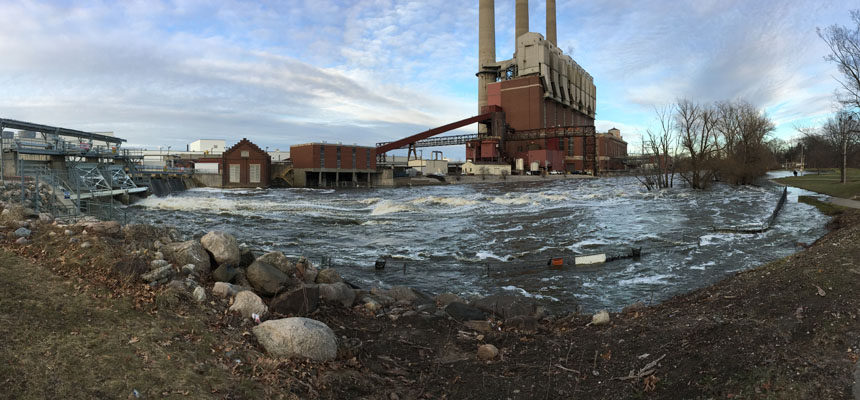With the recent flooding that we’ve been having here in Mid-Michigan, I’ve been thinking about how our landscapes impact storm water, flooding and groundwater infiltration. Many of these ecosystem services that our landscapes provide are often invisible. And once they are out of sight, they are also out of mind. However, our recent weather in Lansing has illuminated two ecosystem services.
Making the Invisible Visible
When the Grand River flooded last week reaching near record levels, there was evidence of how our city and county parks are working hard to provide us with ecosystem services. At our local park, the river overflowed it’s banks, covering the adjacent sidewalks, River Trail, fishing pier, and much of the open lawn.
It is in that area, the open lawn, that the park is serving our community. This open floodway provides valuable space for excess water to “hang out” until the river levels go down. Water that is being stored in this and other local parks is water that isn’t knocking on your door or coming into your basement!
A second way that our landscapes impact storm water is by intercepting rain before it reaches our storm sewers and flows directly into our rivers and lakes. (I’ve written before about vast impervious surfaces that comprise much of our urban development and the challenges that they impose on maintaining sustainable ecosystems.) Trees provide a vital service to us on this front, but it often goes unnoticed…until yesterday’s snow storm.
Trees Intercepting Storm Water (Snow or Rain)
I was making lunch yesterday when I looked out the window to observe how much snow had accumulated on our grass. Though it had been snowing all morning, our grass was still mostly green. When I looked next door, I noticed that our neighbor’s lawn was completely white!
I did a double take. How is our yard different than our neighbor’s? And then it clicked. Our large silver maple tree’s branches were intercepting the snow and keeping it from accumulating on our grass.
Now, can you imagine the effect that this tree (any tree), when fully leafed-out has on slowing rainfall during the summer months?! This is significant. The water that gets intercepted by the tree doesn’t make it into the storm sewer. It doesn’t flood our waterways.
You’ve probably experienced this benefit yourself, too. Like the time that you were stranded in a sudden rainstorm and there was no shelter in sight. The best place to wait out the rain was under the canopy of a mature shade tree. (Unless, of course, there was lightning, but that’s a different conversation!)
Our landscapes are sneaky. They don’t advertise or proclaim the cool things that they are doing to make our lives better. But be assured, landscapes are improving of our lives everyday!






Leave a Reply